Snakes and Ladders Game Project in C++
In this game project, I have presented the source code along with the algorithm and flowchart for the project under the name “Viper Buzz”. ‘The Viper Buzz” is a reflection of the famous classic game ‘Snakes and Ladders’. Designed as a computer version of the South Asian game, this final year project is written on C language using GNU GCC compiler on Code::Blocks IDE. It is an entertaining game that has been made user friendly with multiple user compatibility.
This snakes and ladders game is primarily designed as a semester project. It particularly aims at imparting general workable and practical knowledge about C and lets the beginners have adequate concept on programming small to big projects. It is developed with a hope to increase the programming logic and also to provide substitution to the classical game “Snake and Ladder”.
Unlike other projects, there are many files, besides the source code files, that make up this snakes and ladders project in C. You can directly download the program files of this project from the link below.
Download Snakes and Ladders Game Project in C with Source Code (Updated: Sound Files)
[sociallocker]
Download Snakes and Ladders Game Project in C with Source Code (Updated: Sound Files)
[/sociallocker]
About Snakes and Ladders Game:
The game includes the facilities such as saving and loading the game. The saved games are password protected so that only the authorized user can load the previously saved game. The snakes and ladders game project comprises of multiple functions (scroll down to view the description for each) which can be dealt at ease. Attempt has been made to present the program in user friendly environment.
Objectives, Features and Scope:
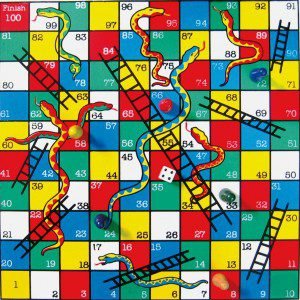
- To use different user defined function, to break a program into many simplified parts to deal with and to make it easier to understand the codes too.
- To promote the use of array in general programming for simplified version of the program.
- To apply the file handling concepts in order to retrieve the player’s data files that contains the data of the players.
- To use minimum graphics as far as possible to make the program execute fast but also user friendly side by side.
- To use general concept of c language to develop a simple snakes and ladders game that as a whole entertains the user.
FEATURES
- Compatible as multi-player game.
- Facility to save the game.
- Open the saved game using the password pre-defined by the user.
- Use minimum graphics in snakes and ladders as far as possible avoiding complex codes.
SCOPE
- Users preferring the classical games can switch to the game.
- Beginners in computer programming can take hints via the mini project to boost up their programming techniques.
- Can be brought in practice in training centers that offers basic programming courses.
- Can be the best choice as stress relieving game in the busy life pattern of the people in present life.
- Simplicity and efficient is main fact that we get using the c language, so user can execute snakes and ladders in each and every computer almost.
- Can be milestone for the programmers trying to learn to build projects in C.
Here is a block diagram for this Snakes and Ladders game labelled as “The Viper Buzz”.
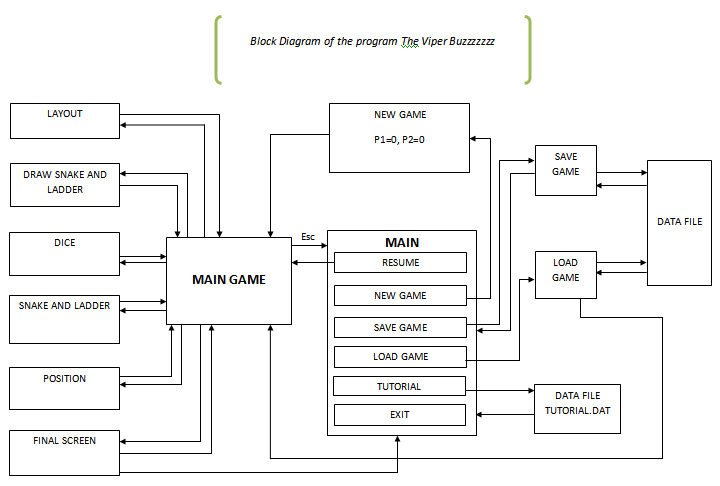
Functions Used:
Main()
This function is the main function. This function contains the control of the whole game. User can switch to resume, new game, load game, save game, tutorial and exit from this function. It calls the respective function as user’s input. In this function user can use pre-defined short cut keys too.
Save game()
This part of the program is called from the main function when user wishes to save the game. The player can provide his own password to protect the game from other users. In snakes and ladders, this function calls the password function to get the password from the user. After getting the password the name of game, the name of players, and the value of the player is stored in a file named save.dat that can be reopened further.
Loadgame()
This function enables the users to load the initially saved snakes and ladders game. In order to prevent the unauthorized use of the loaded game, there is a password system that user has to go through before he opens or loads the saved game. In order to get game loaded user has to input the game name and the password per defined or per entered. Password functions is called for password input and for matching of the password and the game name data is read from the data file save.dat.
Tutorial()
This function in the program prints the tutorial of the snakes and ladders i.e. the help of the game, color indication and so on. The function uses a data file that contains the tutorial of the game. After printing the tutorial the control is transferred to main function.
Firstscr()
This function generates the first screen appeared when the program is executed. This function includes some animations and the snakes and ladders title. This function gets control until unless any key of the key board is hit. If any key of the key board is hit the control flows to main function.
Main game()
This is the function from where all the game is executed . From this function firstly the layout of the board is called. Then the vipers and the ladders are printed. Then the dice function is called and returned value is added to respective player’s position. Then after the viper and ladder function is called to check the viper and ladder position. Then after the players are displayed at the new position. At last eofgame function is called in this snakes and ladders if the player’s value equals to 100.
Layout()
In this function, the general layout of the board is drawn as like in classical game. This function does not get control for long. As soon as it get the control it prints the layout of the board and the control goes to the main game function.
Drawviperandladder()
In this function, the vipers and ladders are drawn on the board. This function is called from the main game function of this viper buzz project. The viper are represented by the red color and the ladders are represented by the green color.
Dice()
This function is for the value of the dice as per user’s reaction. In snakes and ladders, his function returns an integer value if any key of the keyboard is hit. The value is returned to the main game function. In addition to the dice rolling, this function holds the screen and also responds to the escape key pressed. If escape key is pressed, it flows control to the main menu else the control flows to main menu.
Position()
This is the function locating the player in the board of snakes and ladders. This function prints a white space in the old position and it prints the representation character to the new location as the value of the player. The main aim of this function is to prints the player’s indicator in the respective position.
Viperandladder()
In this function the player’s position is compared with the initial position of the ladder and respective value of the player is changed only if the initial value matches. In addition to that this function checks the hit condition also. The control flows to the main game after execution of snakes and ladders.
Locate(int , int)
This function is used in our program to set the cursor position on the different location of the screen. It takes two arguments and sets the cursor position according to the arguments.
Draw()
In this snakes and ladders game project, draw() function helps to print the dice box and the data of the player on the box. It is called each time loop executes so that it overlaps the initial mesh created. This function displays the player’s current position, player’s name and turn.
Eofgame(char , int)
This is the final screen after any one of the player reaches to the position of 100. The main loop of the main game function in this snakes and ladders gets break and this function is called. In this function two arguments are passed i.e. firstly the player’s name and the player’s code. This function has the control until unless a key is pressed.
Password(char)
In this function, an address is passed as argument and entered password is returned for the pointer. In this snakes and ladders game project, the character that user input is take and the asterisks are printed in place of the character to avoid the identification. This function is called from save game and the load game.
Playfilesync(char)
This function is used in the program to play the sound of the game. This function enables the programmer to embed the sound in their console based program. This function takes the file name to be played. The file to be played should be inwav format.
Algorithm & Flowchart:
Here, individual algorithms and flowcharts have been present in a sequential manner for the functions that make up this gaming project.
1. main ()
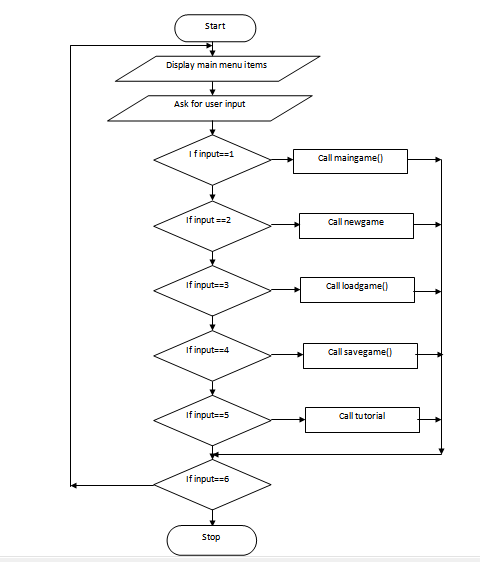
Step 1: Start
Step 2 : Display the menu items.
Step 3: Check the user input and go to respective functions.
Step 2 : Display the menu items.
Step 3: Check the user input and go to respective functions.
- 3(a): If 1 go to main game() function
- 3(b): if 2 go to new game
- 3(c): If 3 go to load game
- 3(d): If 4 go to save game
- 3(e): If 5 go to tutorial
- 3(f): If 6 go to step 4.
Step 4: Stop
2. main game()
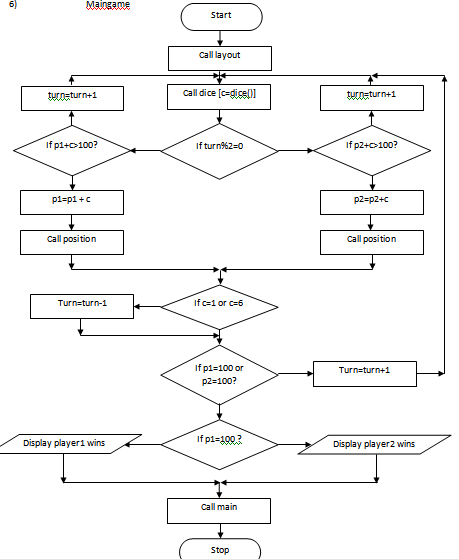
Step 1: Start
Step 2: Display the layout of the board of snakes and ladders from layout function.
Step 3: Call the dice function and store returned value to a variable(c)
Step 4: Check whether the p1 and p2 value is zero or not
Step 2: Display the layout of the board of snakes and ladders from layout function.
Step 3: Call the dice function and store returned value to a variable(c)
Step 4: Check whether the p1 and p2 value is zero or not
- 4(a): If yes, check the dice value
- if it is 1 or 6 change respective player’s value to 1.
- 4(b): If no increase the value of turn, call position function and go to step 3.
Step 5: Check whether sum of player’s value and dice(c) greater than 100 or not
- 5(a): If yes increase value of turn and go to step 3,
Step 6: Check whether sum player’s value and dicer equals 100 or not
- 6(a): if yes, display the player name as a winner got main.
- 6(b): if no, add the players value and dicer.
Step 8: Call the function position to locate the player on the board.
Step 9: Check whether dice value is 1 or 6.
Step 9: Check whether dice value is 1 or 6.
- 9(a): if yes, decrease turn by 1.
Step 10: Increase the turn by 1.
Step 11: Go to step 3.
Step 12: Stop
Step 11: Go to step 3.
Step 12: Stop
3. New game()
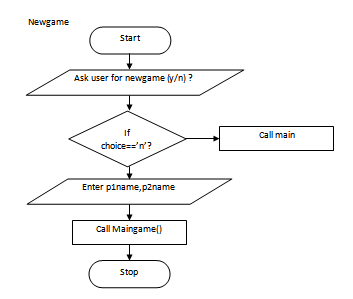
Step 1: Start
Step 2: Ask user whether to start a new game or not?
Step 3: check the input character
Step 2: Ask user whether to start a new game or not?
Step 3: check the input character
- 3(a): if yes,
- Assign player1’s value, player2’s value and turn to 0
- Ask for player1’s name and player’s name and store it to global structure of snakes and ladders.
- Call the function main game and change the flag value.
- 3(b): If no call the function main menu.
Step 4: Stop
4. Save game()
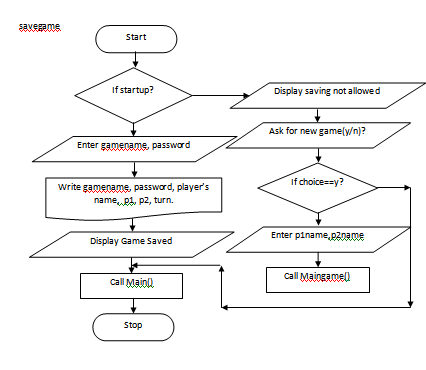
Step 1: Start
Step 2: check the flag value initialized as global is equal to 46.
Step 2: check the flag value initialized as global is equal to 46.
- 2(a): if matches to start up value (46) request user to start a new game and change the flag value.
- 2(b): If does not matches to startup value (46)
- Open a fie to store the data in append mode.
- Ask user for the input of game name and password.
- Write, player’s data, position , game name and password to the file.
- Display game saved
- Close the file and return to main menu.
Step 3: Stop.
5. Load game ()
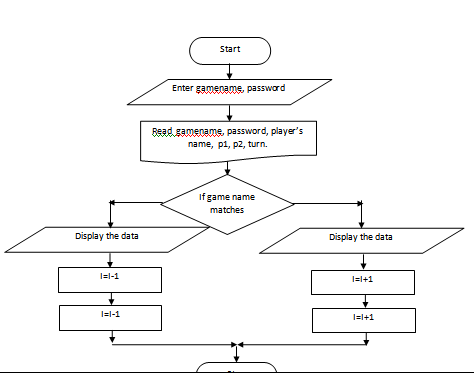
Step 1: start
Step 2: Ask user for game name and password.
Step 3: Open initially saved fie from save game function in read mode.
Step 4: Compare the game name and password from user and data file.
Step 2: Ask user for game name and password.
Step 3: Open initially saved fie from save game function in read mode.
Step 4: Compare the game name and password from user and data file.
- 4(a): If both game name and password matches
- Display match found.
- Assign player’s data and name to respective global variables
- Call the main game function
- 4(b) If match is not found go to main menu of snakes and ladders
Step 5: Stop
6. Layout ()
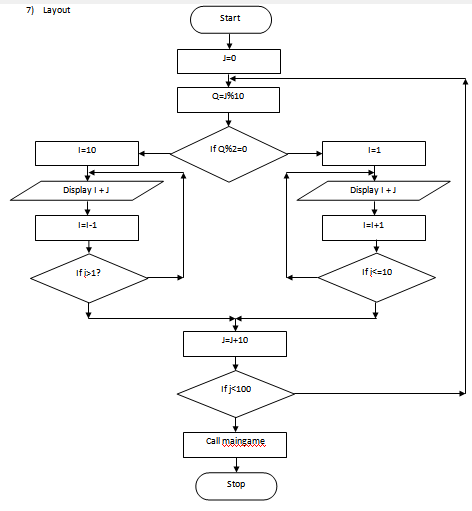
Step 1: Start
Step 2 : Initialize a variable (j) as 0.
Step 3: Find the quotient when j is divided by 10.
Step 4: Check the quotient value is even or not?
Step 2 : Initialize a variable (j) as 0.
Step 3: Find the quotient when j is divided by 10.
Step 4: Check the quotient value is even or not?
- 4(a): if yes,
- Assign the value of i as 1.
- Display the sum of i and j.
- Increase the value of i by 1.
- Check the value of i whether it is less than equals to 10 or not?
- If yes, goto step 4(a).ii
- If no goto step 5.
- 4(b): If no,
- Assign the value of I as 10
- Display the sum of I and j.
- Decrease the value of I by 1
- Check whether the value of i is greater than 0 or not?
- If yes, goto step 4(b).ii
- If no, go to step 5.
Step 5: Increase the value of j by 10.
Step 6: Check whether j if less than 100 or not?
Step 6: Check whether j if less than 100 or not?
- 6(a): If yes, goto step 3.
- 6(b): if no, goto step 7.
Step 7: Go to main() function of snakes and ladders.
Step 8: Stop.
Step 8: Stop.
7. Drawviperandladder ()
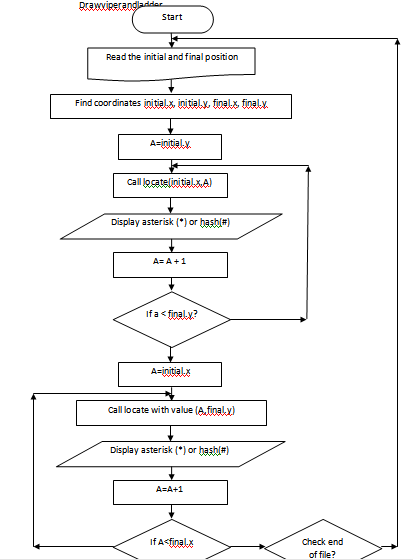
This flowchart is continued below:
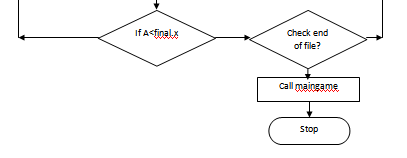
Step 1: Start
Step 2: Open the data file containing the initial and final position of viper and the ladder.
Step 3: Read initial and final position of viper and ladder.
Step 4: Find the coordinates of intial and final position of the snakes and ladders and store to initial.x, initial.y, final.x and final.y.
Step 5: Initialize a variable (a) with y coordinate of initial position.a=initial.y
Step 6: Locate the Cursor position as initial.x and a.
Step 7: Display asterisk (*).
Step 8 : Increase the value of a by 1.
Step 9: Check whether the value of a is less than final.y or not?
Step 2: Open the data file containing the initial and final position of viper and the ladder.
Step 3: Read initial and final position of viper and ladder.
Step 4: Find the coordinates of intial and final position of the snakes and ladders and store to initial.x, initial.y, final.x and final.y.
Step 5: Initialize a variable (a) with y coordinate of initial position.a=initial.y
Step 6: Locate the Cursor position as initial.x and a.
Step 7: Display asterisk (*).
Step 8 : Increase the value of a by 1.
Step 9: Check whether the value of a is less than final.y or not?
- 9(a): If yes, go to step 6.
- 9(b): If no, go to step 10.
Step 10: Initialize a variable (b) with x coordinate of initial position. b=initial.x
Step 11: Locate the Cursor position as b and initial.y.
Step 12: Display asterisk (*).
Step 13 : Increase the value of b by 1.
Step 14: Check whether the value of b is less than final.x or not?
Step 11: Locate the Cursor position as b and initial.y.
Step 12: Display asterisk (*).
Step 13 : Increase the value of b by 1.
Step 14: Check whether the value of b is less than final.x or not?
- 14(a): If yes, go to step 11.
- 14(b): If no, go to step 15.
Step 15: Check whether it is end of file or not?
- 15(a): If yes, go to step 17.
- 15(b): if no, go to step 3.
Step 16: Go to main() function of snakes and ladders.
Step 17: Stop.
Step 17: Stop.
8. Dice ()
Step 1: Start.
Step 2: Initialize a variable as 1.
Step 3: Increase the value of the variable by 1.
Step 4: Check whether there is keyboard input or not?
Step 2: Initialize a variable as 1.
Step 3: Increase the value of the variable by 1.
Step 4: Check whether there is keyboard input or not?
- 4(a): if yes, return the value of the variable as the dice value and go to main().
- 4(b): if no, go to step 5.
Step 5: Check whether counter variable equals 6 or not?
- 5(a): if yes, assign the value of counter as 1 and goto Step 3.
- 5(b): if no, goto Step 3.
Step 6: Stop.
9. Position ()
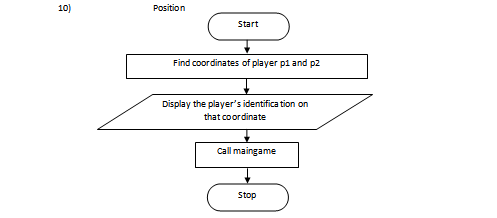
Step 1: Start.
Step 2: Display white space on the initial position of the players.
Step 3: Get the new player’s position.
Step 4: Locate the X and Y coordinate of the player’s position.
Step 5: Display the respective player to the position.
Step 6: Go to the main.
Step 7: Stop.
Step 2: Display white space on the initial position of the players.
Step 3: Get the new player’s position.
Step 4: Locate the X and Y coordinate of the player’s position.
Step 5: Display the respective player to the position.
Step 6: Go to the main.
Step 7: Stop.
10. Viperandladder ()
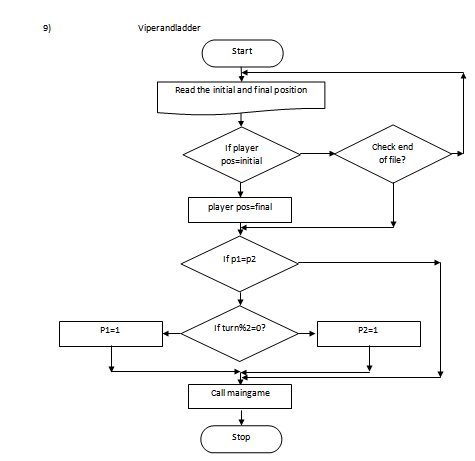
Step 1: Start.
Step 2: Open the file containing initial and the final position of the viper and ladder.
Step 3: Read initial and final position of viper and ladders.
Step 4: Check the player’s position with the initial position of the viper and ladder, whether it matches or not?
Step 2: Open the file containing initial and the final position of the viper and ladder.
Step 3: Read initial and final position of viper and ladders.
Step 4: Check the player’s position with the initial position of the viper and ladder, whether it matches or not?
- 4(a): If yes, Assign the value of player with the final value of viper or ladder.
- 4(b): if no, go to Step 5.
Step 5: Check whether the position of the player 1 and the position of player 2 matches or not?
- 5(a): If yes, Check the turn whether it is odd or not?
- If yes, assign player 1’s position equal to 1.
- If no, assign player 2’s position equal to 1.
- 5(b): if no, go to step 6.
Step 6: Go to main().
Step 7: Stop.
Step 7: Stop.







No comments:
Post a Comment